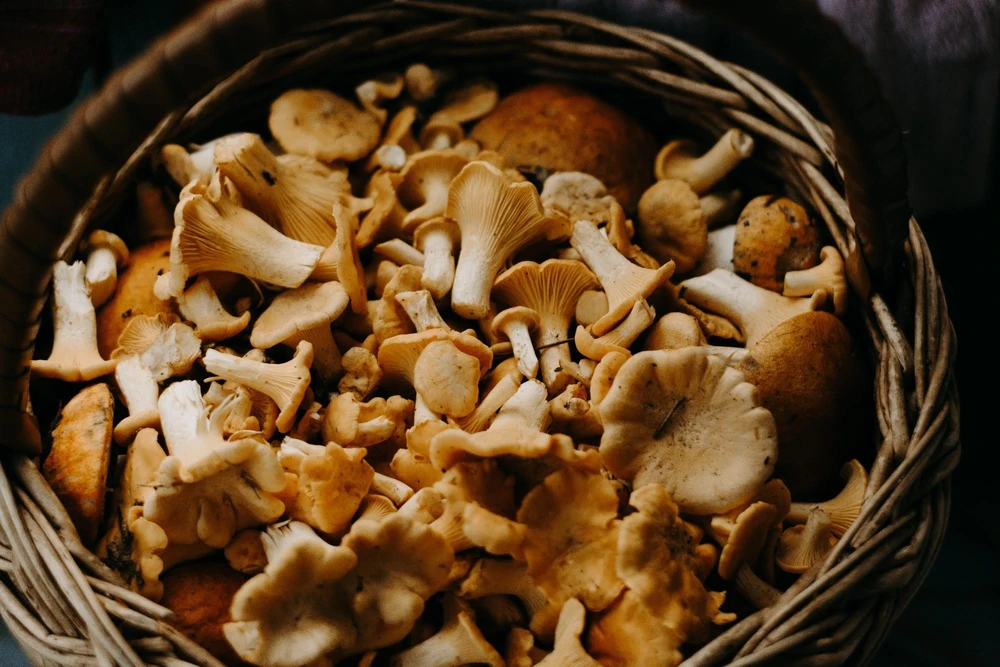Foraging for wild edible mushrooms can be both a deeply satisfying hobby and a unique culinary experience. However, it is crucial to develop the skills to identify, harvest, and safely prepare these woodland delights. In this article, we will explore a few edible mushrooms commonly found in North American forests and offer useful tips for confident foragers. In addition, you can explore varieties like the puffball mushroom to expand your understanding of other edible mushrooms that can be safely consumed.
Chanterelle Mushrooms (Cantharellus)
Chanterelles are distinguished by their golden orange color and trumpet-like shape. Their caps have false gills, which are thin, shallow ridges that run down the stem. The white flesh should be firm and aromatic with a fruity, apricot-like scent.
To harvest these mushrooms, look in mixed hardwood forests with oaks, birches, and conifers during summer and fall. Be cautious of false chanterelles, which have true gills rather than ridges. Pinch the stem at ground level and gently twist it to remove from the soil.
Morel Mushrooms (Morchella)
Morels, prized for their earthy and nutty flavors, are one of the most sought-after wild mushrooms. They are characterized by their sponge-like, honeycomb-patterned caps and hollow stems. To ensure you’ve found a true morel, slice it in half lengthwise to check for a completely hollow interior.
Seek out areas with disturbed or burned soil, near dead or dying trees, particularly ash, elm, and apple. Harvest in early spring when the soil has warmed. Cut the mushrooms just above the ground using a sharp knife and avoid pulling them out.
Porcini Mushrooms (Boletus edulis)
Porcini mushrooms, often called ‘king boletes’, are renowned for their rich taste and meaty texture. These mushrooms feature a large, brown cap and thick, swollen white stem. Ensure a porcini identification by checking for a sponge-like underside of the cap as they do not have gills.
Search near conifers, oak, chestnut, or birch trees during summer and fall. Avoid insect-infested or decaying mushrooms by checking the flesh for firmness. Use a knife to cut the stem at the ground level and twist gently to separate it from the mycelium.
Hen of the Woods (Grifola frondosa)
Also known as ‘maitake’, hen of the woods is a large, fan-shaped, frond-like mushroom that grows in clusters near the base of hardwood trees. They are grayish-brown with overlapping layers, and their firm, white flesh has an earthy, mildly sweet taste.
Look for specimens at the base of oak trees in the fall. Wait for mature specimens, at least 6-8 inches in diameter, before harvesting. Cut the mushroom at the base using a sharp knife to harvest.
Oyster Mushrooms (Pleurotus)
Oyster mushrooms display a distinct appearance with their fan-shaped, off-white to grayish caps, which grow in overlapping clusters on dead or dying hardwood trees. The soft, smooth flesh offers a mild, sweet taste when cooked.
Target fallen logs or dead trees during spring, summer, and fall. Gently twist the mushroom away from the tree to remove it or use a knife to cut it close to the base.
Cooking and Storing Wild Mushrooms
Once you’ve successfully foraged and identified your edible mushrooms, it’s time to bring them into the kitchen. To preserve their quality, clean the mushrooms using a soft brush or damp cloth to remove dirt and debris. Many wild mushrooms can be sautéed, grilled, or roasted, depending on your personal preference. When storing fresh mushrooms, keep them in a paper bag in the refrigerator to maintain their freshness, and never store them in plastic, which can cause them to become slimy.
Potential Health Benefits of Edible Mushrooms
In addition to their culinary value, edible mushrooms are also believed to have numerous health benefits. They are rich in vitamins, minerals, and antioxidants, and have been linked to various health benefits, including immune system support, anti-inflammatory properties, and cholesterol regulation. Incorporating wild mushrooms into your diet can be a tasty and nutritious way to expand your culinary horizons.
Foraging Safety and Ethics
While foraging can be an enjoyable and rewarding experience, it is crucial to be aware of the safety risks and ethical considerations involved. Be certain of your mushroom identification before consuming any foraged fungi, as consuming toxic mushrooms can lead to serious health complications or even death. Additionally, practice responsible foraging by not over-picking an area or damaging the environment. By following these guidelines, you can ensure a safe and enjoyable foraging experience.
Conclusion
As you embark on your foraging journey, remember that proper identification and harvesting techniques are crucial for ensuring a delightful woodland-to-table experience. It is always best to consult a local expert or join a foraging group to become more proficient in discerning safe, edible mushrooms from their potentially toxic counterparts. Happy foraging!

